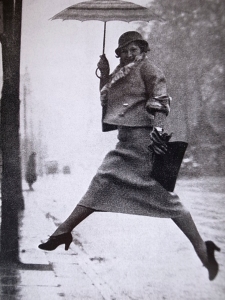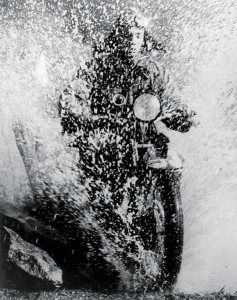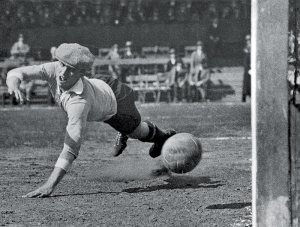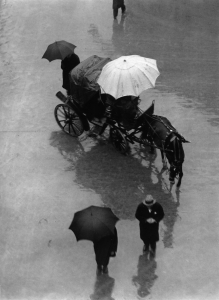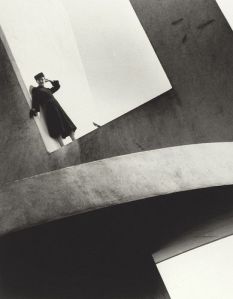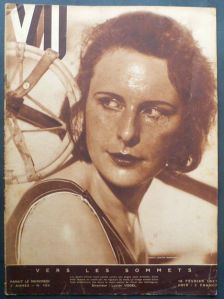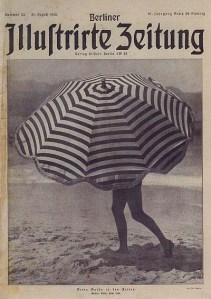The Influential, Yet Forgotten Martin Munkasci, Part I
By Cliff Cheng
The Inspiring Fashion Photography History Blog
© 2014, 2015 Cliff Cheng
ALL RIGHTS RESERVED
Copyright Disclaimer – None of the photographs in this article are owned or taken by myself. They are the property of their respective owners. Fair use is made of these photographs for non-commercial educational purposes.
Introduction
After our May 27, 2014 article on Martin Munkasci 1934 puddle jump shot – comments were received asking who is Martin Munkasci? This week we shall answer. Munkasci was a sports, aerial, fashion and celebrity photographer and journalist.1 He worked in Hungary, Germany and New York from the 1920s to 1960s.
There is some uncertainity about his identification that we must first attempt to clear up. While there is agreement on his birthday, May 18, 1896, there is disagreement on his place of birth and the spelling of his birth name. According to the Getty Research Database, he was born in Cluj-Napoca, Romania.2 Wikipedia says he was born in Kolosvar, Hungary on.3 Tuchman says it was Transylvania, which is a region in the country of Romania.4 The Getty Research and Luminous Lint Databases both says his name was – “Martin Marmorstein.”5 Wikipedia reports his birth name as – “Mermelstein Marton.”6 Kimmelman and Tuchman said his name was – “Morton Mermelstein.”7 It is unknown when he changed his name to – Martin Munkasci.8 He had a younger brother Muky Munkasci who was a celebrity portrait photographer.9
His importance in the history of fashion photography is not in his fashion pictures that are well known to the present generation – although they are worthy to be known, which is why we have written this article. His importance lies in the number of great photographers who acknowledge that he influenced them – Richard Avedon, Helmut Newton, Henri Cartier-Bresson, to name a few. Avedon and Newton are 2 of the 3 Great Masters of Fashion Photography. Cartier-Bresson is often regarded as the most influential photojournalist. Avedon consistent ranks as the most influential photographer of all time (see our April 21, 2014 article). When photographers of this caliber all say Martin Munkasci was an influence on them, his work merits a closer look.
Davies even gives Munkasci the title of – The Father of Fashion Photography.10 He certainly is one of the central pioneers of fashion and sports photography. To call him the one and only “Father of Fashion Photography” would require extensive research to rule out other possibilities.
5 Well-Known Photographs
Let us discuss 5 well-known Munkasci photographs before we go further. “Well-known” is a relative term. The case maybe these photos are better known than the photographer who made them.
In May of 1977, Henri Cartier-Bresson wrote:
I saw a photograph of three black children running into the sea, and I must say that it is that very photograph which was for me the spark that set fire to the fireworks. It is only that one photograph which influenced me. There is in that image such intensity, spontaneity, such a joy of life, such a prodigy, that I am still dazzled today.11
1930
Cartier-Bresson changed careers from being a painter to a photographer after seeing this photograph.13,14 “it made me realise that photography could reach eternity through the moment… I said, “Damn it,” I took my camera and went out into the street.”15
*
1931, The Dance Team of Tibor Von Halmay and
Vera Mahlke Having a Coffee Break, Berlin16
The negative of this shot is often on display at exhibits of Munkasci’s work to prove it was shot in-camera since people are often astounded that someone can dance up a wall.
*
1933, Harper’s Bazaar, Lucile Brokaw On A Long Island Beach
The photo below is Munkasci’s first Harper’s Bazaar assignment. Kessler wrote that –
His first assignment (for Harper’s Bazaar) was a bathing suit reshoot with socialite model Lucile Brokaw. Munkacsi headed to the beach on Long Island and had Brokaw run toward the camera, cape flying in the wind — a classic example of Munkacsi’s knack for photographing an everyday location that, by studied placement of subject and angle, became a new stage.17
Davies continues:
On a blustery November day in 1933 Carmel Snow, the recently appointed editor at Harper’s Bazaar, brought a little-known Hungarian photographer to Piping Rock beach on Long Island to shoot a swimwear spread. ‘The day was cold and unpleasant,’ she recalled in her memoirs, ‘not at all auspicious for a “glamorous resort” picture. I was shivering in sympathy with poor Lucile.’…As Lucile stood trembling in the gauzy cape and suit, Snow began to despair: ‘The photographer didn’t speak a word of English; his friend seemed to take forever to interpret.’ The photographer began making ‘wild gestures’ with his arms. ‘What does he want?’ Snow asked, but Lucile understood, and began running towards him.
At that moment Martin Munkácsi (pronounced moon-kashi) took the picture that would make both his career, and photographic history. Until then fashion was a staged affair, using mannequin-like models in a musty studio. Here, on Lucile’s face, her chin stretched resolutely forward, was a genuine, breathless grin, matched in ebullience by the triumphant billowing of the cape behind her. ‘This was never done before,’ Snow wrote. ‘This was the first big innovation I introduced to Harper’s Bazaar .’18,19
An 11 year old boy living in the New York City saw this picture.21 It inspired him so that he tore the picture out of Harper’s Bazaar and pasted it to the ceiling above his bed.22 He recalled later that as an 11year old – the women in Munkasci’s photographs – “[strode] parallel to the sea, unconcerned with his camera, freed by his dream of them, leaping straight-kneed across my bed.”23 That little boy’s name was Richard Avedon.24 Further he said – “He brought a taste for happiness and beauty and a love of women, to what was, before him, a joyless lying art.” Richard Avedon, Harper’s Bazaar, August, 196325
Cook suggests that Munkasci “innovation” was unintentional, that he did as he always did in sports photography.26
It should be noted that prior to World War II, fashion magazines often asked socialites to model. Being a model was not entirely respectable in some circles. Socialites had more legitimacy due to their higher social standing.
We will discuss his sports photography in a few pages.
*
In our May 27, 2014 article, we discussed Martin Munkasci and his 1934 puddle jump shot.
April, 1934, Harper’s Bazaar
We showed his original 1934 shot (see above) and Richard Avedon’s 1957 homage with the model Carmen dell’Orefice. Then we showed Bill Cunningham’s spontaneous journalistic 1986 picture in which he caught Carmen jumping a puddle on a rainy day in New York City.27 Lastly, we showed Elliott Erwitt’s romantic Paris homage to Munkasci made in 1989.
*
His 1936 photo of Fred Astaire dancing is definitive.28
Photojournalism and Sports Photography
In 1913, at age 17, Munkasci was hired as a sports reporter for Az Est magazine.29 When World War I started, he became a photographer for Az Est (The Evening) using a camera he made himself.30 He was a self-taught photographer.31 There is no information available about his inspirations and his early years.32
In 1923, Munkasci was shooting on the streets, location unknown, and photographed a person being killed.33 Those photographs became important evidence in the subsequent murder trial.34 Munkasci became famous as a result of the trial.35,36 That photograph is apparently unavailable today.37
1923, Motorcyclist, Budapest
In 1923, this shot was considered innovative. Film emulsions were slow. The freeze action, especially a splash requires a faster shutter speed. In order to freeze action, sports photography was often done in daylight. He used a “4×5 reflex camera by Adams of London for portraits and a 4×5 speed graphic camera for the outdoors.”38
Not only did Munkasci master the technical component, he added the artistic element with his framing. Munkasci shot at innovative angles.39 His fellow photographers even called him “Crazy Angle Munkasci.40
Here is an eyelevel shot from his Goalkeeper series in 1928.
Even by today’s standards this would be considered a good shot. He captured the goalie breaking his fall with one arm and two-legs in-the-air. The limbs are sharp by the standards of that day.41 There is just enough dust to indicate motion in the ball. The ball is distorted and softly focused due to motion blur but this is acceptable given that the Goalie is airborne.
Here is a shot reminiscent of Eadweard (Edward) Muybridge’s 1878 horse in motion series.42
Here is another of Munkasci’s earliest surviving shots. A high angle shot such as this was innovative for 1927 when this picture was shot in Palmero, Sicily.
What he did with these and other sports photos would later be applied to his fashion photography. Here is a fashion photo for Harper’s Bazaar, photographed at the World’s Fair, September 1938, that best shows the “crazy angle.”
Seeing this shot, one wonders if Bill Silano, the subject of our April 23, 2014 article was influenced by Munkasci? We asked Silano’s protégé, fashion photographer Christian Di Lalla if there was an influence. Christian said he did not recall Silano mentioning him.
*
In 1927, Munkacsi was 31.43 He immigrated to Berlin, Germany.44 1928, Munkacsi become a staff photographer at Berliner Illustrirte Zeitung (BIZ), a picture magazine with 2M subscribers.45 He also shot for the German fashion magazine Die Dame.46 He shot 3 covers for BIZ – “aloft in the dining room of the dirigible Graf Zeppelin; another with Greta Garbo’s legs appearing beneath a large, striped beach umbrella; and a third of Leni Riefenstahl on skies when she was acting in mountain-themed movies”.47
1931, Leni Riefenstahl48
1932, On Holiday With Greta Garbo
Munkasci worked in Berlin from 1927-1934. His studio was near the home of a sickly young German Jewish boy named – “Helmut Neufstadler.”49 This young boy was fascinated by photography and the work of Munkasci.50 He would spy on Munkasci because he was too shy to approach him.51 Due to WWII and his family’s escape from Hitler, that young boy would later change his name to – “Helmut Newton.”52
*
Please visit us next month for Part II of this series in which we will discuss and show Martin Munkasci’s work after he immigrated to the U.S. to be a Harper’s Bazaar, LIFE and Ladies Home Journal Staff Photographer, his rise, fall, death, controversy and restoration.
___________________________________________________________
About
Cliff Cheng has a unique set of qualifications to write the history of fashion photography by combining his backgrounds as a fashion photographer with 18 years’ experience and being a film historian. Cliff is starting to re-emerge as a photographer after a time away. Please visit his website www.cliffchengscreates.com. As film historian, he earned the Master of Arts degree (M.A.) from California State University Los Angeles with additional training at the University of Southern California Film School. (He later earned a doctorate from USC in another field.) He taught film history at the Los Angeles and Long Beach campuses of the California State University. He has studied the works of Writer-Directors Billy Wilder, Woody Allen, Yasujiro Ozu, Director Alfred Hitchcock, and Writer Paddy Chayefsky. Cliff curates fashion photographer Lillian Bassman’s Facebook page https://www.facebook.com/pages/Lillian-Bassman-A-Celebration-of-Her-Fashion-Photography/283164151701560 and the Facebook page of Wilhelmina Cooper, the model who holds the record for being on the cover of American Vogue most, 28 times https://www.facebook.com/pages/Wilhelmina-Cooper-A-Celebration/286939354681228
____________________________________________________________
Inspiring Fashion Photography History Blog
© 2014, 2015 Cliff Cheng
ALL RIGHTS RESERVED
4 Tuchman, Phyllis. (2009). Martin Munkasci. Obit-magazine. June. http://mastersofphotography.blogspot.com/2011/06/martin-munkacsi.html.
5 http://www.luminous-lint.com/app/photographer/Martin__Munkacsi/A/. http://www.getty.edu/vow/ULANFullDisplay?find=&role=&nation=&prev_page=1&subjectid=500012064.
6 Ibid.
7 Kimmelman, Michael. (2007). The innovator and master, side by side. New York Times. Jan. 19. http://www.nytimes.com/2007/01/19/arts/design/19munk.html?pagewanted=print&_r=0. Tuchman, Phyllis. (2009). Martin Munkasci, Obit-magazine. June. http://mastersofphotography.blogspot.com/2011/06/martin-munkacsi.html.
8 Tuchman (2009) says, Munkasci’s father changed the name to “Munkacs,” a variation of the name of a village in Hungary. There is suggestion that the name change was to avoid discrimination based on his Jewish ethnicity – http://www.anothermag.com/current/view/1218/Martin_Munk%C3%A1csi.
9 http://www.luminous-lint.com/app/photographer/Martin__Munkacsi/A/, http://www.christies.com/lotfinder/memorabilia/joan-crawford-muky-munkacsi-5095417-details.aspx, http://www.nytimes.com/movies/person/1039617/Muky-Munkacsi. He was Chief Publicity Photographer at Warner Bros. for 25 years, http://en.wikicollecting.org/menyhert-muky-munkacsi-wellknown-140813-lot-1046. His last credit on IMDB is from 1979, http://www.imdb.com/name/nm0611630/bio?ref_=nm_ov_bio_sm.
10 Davies, Lucy. (2011). Martin Munkasci: Father of Fashion Photography. Telegraph. July 3. http://www.anothermag.com/current/view/1218/Martin_Munk%C3%A1csi. http://fashion.telegraph.co.uk/news-features/TMG8597512/Martin-Munkacsi-father-of-fashion-photography.html.
11 Ibid.
12 Regrettably, a larger version of this picture was not found on the internet.
13 Ibid.
14 Tuchman (2009) noted that unbeknownst to Cartier-Bresson, Munkasci had cropped the photo. Cropping was against Cartier-Bresson’s concept of the decisive moment. Kessler (2009) said Cartier-Bresson kept this photo on his desk for the rest of his life.
15 Ibid.
16 Different sources give different names for this photograph.
17 () added.
18 Davies, Lucy. (2011). Martin Munkasci: Father of Fashion Photography. Telegraph. July 3. http://www.anothermag.com/current/view/1218/Martin_Munk%C3%A1csi. http://fashion.telegraph.co.uk/news-features/TMG8597512/Martin-Munkacsi-father-of-fashion-photography.html
19 There is a discrepancy in dates. Davies (2011) cites Snow as recalling the photograph was taken in Nov. 1933. Beetles & Huxley, the London photography dealer, sells this photograph with the caption Dec. 1933, Harper’s Bazaar http://www.beetlesandhuxley.com/gallery/photographs/lucile-brokaw-harpers-bazaar-december-1933.html. While it is possible to shoot a picture and have it in next magazine month’s issue, it is unlikely. A typical lead time is 3 months in the technology they had in this period. Most magazine print and mail an issue well in advanced of the month it is slated to come out in so subscribers have it days or even a week or more before the beginning of month. One of these sources may have an incorrect date.
20 Unfortunately, we could not find a larger version of this photograph on the internet.
21 https://en.wikipedia.org/wiki/Richard_Avedon. Davies, Lucy. (2011). Martin Munkasci: Father of Fashion Photography. Telegraph. July 3. http://www.anothermag.com/current/view/1218/Martin_Munk%C3%A1csi.
22 Ibid.
23 Ibid.
24 Ibid.
25 Tuchman, Phyllis. (2009). Martin Munkasci, Obit-magazine. June. http://mastersofphotography.blogspot.com/2011/06/martin-munkacsi.html
26 Cook, Fiona. (2011). Martin Munkasci. AnOther. July 13. http://www.anothermag.com/current/view/1218/Martin_Munk%C3%A1csi.
27 Bill Cunningham started the specialty of – Street Fashion Photography. See our May 5, 2014 article.
28 Ibid.
29 Tuchman, Phyllis. (2009). Martin Munkasci, Obit-magazine. June. http://mastersofphotography.blogspot.com/2011/06/martin-munkacsi.html.
30 Ibid.
31 Kimmelman, Michael. (2007). The innovator and master, side by side. New York Times. Jan. 19. http://www.nytimes.com/2007/01/19/arts/design/19munk.html?pagewanted=print&_r=0.
32 We contacted the Center for Photography, Woodstock, New York, in hopes of obtaining a copy of an article that the late-Joan Munkasci wrote about her father in the Center’s defunct journal Photography Quarterly, 54. The Center did not reply. We were hoping that article, entitled – “The Man Who Loved Women,” would shed light on Munkasci’s beginnings as well as other missing pieces in his history.
33 Tuchman, Phyllis. (2009). Martin Munkasci, Obit-magazine. June. http://mastersofphotography.blogspot.com/2011/06/martin-munkacsi.html.
34 Ibid.
36 Tuchman (2009) reported than after seeing the Michelangelo Antonioni movie Blow-up, (1966) in which the lead character, a fashion photographer inadvertently photographs a murder, Munkacsi’s widow remarked the stole the plot from her husband.
37 Copyright Owner Lynn Nafzger did not reply to my inquiry. Munkasci’s dealer, The Howard Greenberg Gallery told me they do not have a copy and Mr. Nafzger was unavailable for interview.
38 Tuchman, Phyllis. (2009). Martin Munkasci, Obit-magazine. June. http://mastersofphotography.blogspot.com/2011/06/martin-munkacsi.html
40 https://www.blogger.com/profile/12174358381421657827. We are unable to find other sources which also say this was his nickname.
41 It appears sharp based on the small (103kb) jpeg we have access to.
42 http://en.wikipedia.org/wiki/Eadweard_Muybridge#Stanford_and_horse_gaits. https://www.google.com/search?q=eadweard+muybridge+horse&espv=2&tbm=isch&tbo=u&source=univ&sa=X&ei=Rx3JU7DjDeWc8AHQyIHoDA&ved=0CBwQsAQ&biw=1366&bih=635#facrc=_&imgdii=_&imgrc=yc6SU3gXdi1UpM%253A%3B8n7DvvFctS90sM%3Bhttp%253A%252F%252Fupload.wikimedia.org%252Fwikipedia%252Fcommons%252F7%252F73%252FThe_Horse_in_Motion.jpg%3Bhttp%253A%252F%252Fen.wikipedia.org%252Fwiki%252FEadweard_Muybridge%3B1536%3B952.
43 Ibid.
44 Ibid.
45 Weekly German magazine https://en.wikipedia.org/wiki/Berliner_Illustrirte_Zeitung, http://en.wikipedia.org/wiki/Martin_Munk%C3%A1csi.
47 Ibid. Greta Garbo was a popular actress in silent and talking pictures. Leni Riefenstahl was a brilliant documentary filmmaker and commercial photographer whose documentaries about the Nazis made her highly controversial figure https://www.youtube.com/watch?v=GHs2coAzLJ8, https://www.youtube.com/watch?v=7TI6yIo-tcc. She was also a good friend of Helmut Newton.
48 It is uncertain if this is the photo is one of the photos referenced. This photo says – UV. It does not say – Berliner Illustrirte Zeitung. The following cover says the later. The photo maybe not be a cover. We lack a translation into English. We are mentioning the highly controversial Riefenstahl as a matter of history. The reader is asked to refrain from projecting his/her political interpretations into her mention.
49 Newton, Helmut. (2003). Autobiography. New York: Nan A. Talese/Doubleday.
50 Ibid.
51 Ibid.
52 Ibid.




